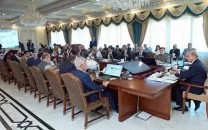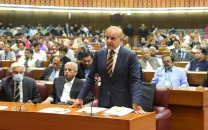Is IS a threat to Pakistan?
Pakistan’s govt, security forces will do well to kill the group in its infancy rather than ignoring threat it poses

The writer is an Associate Research Fellow at International Centre for Political Violence and Terrorism Research of S Rajaratnam School of International Studies, Singapore
Against this backdrop, it is pertinent to assess the group’s operational capability to carve out a niche for itself in the region and what can be the potential fallout of such a development for Pakistan’s militant and security landscape? There are two opposing schools of thought on this issue.
One school of thought holds the view that the discussion of IS’s growing influence in Pakistan has been overhyped by the media and certain vested interests. This school of thought believes gaining space in Pakistan will be difficult for the IS for six reasons. First, the IS is an outsider to the region: the impermissible barriers of language, culture and geography will make it difficult for the group to sow its influence here. Second, the IS sprung up in Iraq and Syria, which were collapsing societies marred by civil wars. Unlike them, Pakistan is a functioning state, run by a democratically-elected government and guarded by an elaborate and robust security apparatus. Third, the well-entrenched presence of veteran militant groups of the Afghan Taliban, al Qaeda and the Kashmiri militant groups leave very little space for the IS to gain a foothold here. Fourth, the IS’s message of the so-called caliphate is oversimplified and out of sync with complicated and isolated pockets of conflict in the region. Fifth, Pakistan is not part of the US-led anti-IS coalition, so the terror group will not pick a bone with the latter. Lastly, the IS follows a different stream of extremist ideology from the one followed by Pakistani terrorist groups. The limited appeal of the ideology followed by the IS in Pakistan will also constrain the group’s influence.
The other school of thought argues that denial about the IS presence in Pakistan is fraught with dangers. This school of thought is of the view that the IS’s stunning military victories, slick social media propaganda campaign, control over vast swathes of territory in Iraq and Syria and monopoly over the modern terrorist iconography have captured the imagination of extremist groups in Pakistan. This school of thought further argues that the IS has the cash, charisma and a successful model to inspire militants in Pakistan. For the cash-strapped al Qaeda and the Afghan Taliban, it will not be easy to retain the support of overambitious new generations of militants in the region. In addition, the readily available ungoverned spaces (physical sanctuaries), an environment conducive to growth of extremist ideologies (social sanctuary), and a large youth cohort susceptible to militant recruitment (demographic sanctuary) make Pakistan naturally attractive for the IS.
So far, Pakistani militant groups have responded to the growing appeal of the IS in three major ways: open rejection, open acceptance or a wait-and-see policy. Groups like al Qaeda, the Afghan Taliban and the TTP core have denounced the IS’s call for establishing a caliphate. Meanwhile, as mentioned above, the three splinter groups of the TTP have openly embraced the IS model while groups like the Jamaatul Ahrar and the Hizb-e-Islami Gulbuddin have adopted a hedging attitude towards the IS.
Given the factionalisation of the TTP, the growing influence of the IS among Pakistani militants cannot be ignored. At present, the threat of the IS in Pakistan is neither too big to pose any serious security threat nor too small to ignore. However, it can grow into something big and serious if any potential advance by it is not checked and seriously dealt with. Pakistan’s government and security forces will do well to kill the group in its infancy rather than ignoring the threat it poses till it emerges as a major security threat.
Published in The Express Tribune, February 28th, 2015.
Like Opinion & Editorial on Facebook, follow @ETOpEd on Twitter to receive all updates on all our daily pieces.

1729685382-0/Untitled-design-(57)1729685382-0-208x130.webp)














COMMENTS
Comments are moderated and generally will be posted if they are on-topic and not abusive.
For more information, please see our Comments FAQ